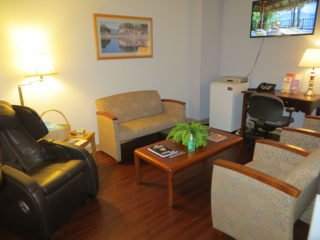
The respite room in HUP's Center for Family Caregivers provides a temporary escape from the stress of having a loved one in the hospital.
More and more, hospitals are putting the needs and expectations of patients as a priority but many are continuing to take a more family-oriented approach to patient care as well. “Taking care of a patient’s family is part of caring for the patient,” said
Mary Walton, MSN, director of Patient and Family Centered Care at the Hospital of the University of Pennsylvania. “Patients are sicker and staying longer; families are more stressed. Now, more than ever, we need to provide more services that center on the needs of patients
and families.”
Many resources are now in place specifically to support families. One is the Care Partner Shower Facility. HUP’s policy promotes family presence and participation in care to improve the patient experience but having no dedicated space to attend to personal hygiene needs can be an additional stress on loved ones. This full-bathroom facility, which requires a unit-specific passcode to enter, includes a shower and access to towels, and individual bottles of shampoo and soap.
Offering nourishment, in the form of a comfort bag, is another way of demonstrating our care and concern for family members during a difficult time. “When a patient is really ill and possibly near the end of life, the family doesn’t want to leave. Or families may arrive in the middle of the night, after driving hours,” Walton said. “It’s important that they have nourishment.”
The bag includes bottles of water, granola bars, raisins, and cheese and crackers. “HUP provides a comfort tray during the day that staff can order for families keeping vigil, but, now, once food services have closed, we can offer the comfort bag,” Walton said.
The most recent support measure created for families is the Center for Family Caregivers. Centrally located an escalator ride from the hospital’s main entrance, the Center is many things to many people. Some use its computer, fax and printer to help keep the every-day parts of their lives on track without leaving the hospital. Others see its “respite room” – with massage chair, peaceful images and soft music -- as a temporary escape from the stress of having a loved one in the hospital, providing more privacy than a waiting room.
And many use it just to take a deep breath and regroup. One parent whose child was in a devastating accident came here from a rural area. The city seemed like a foreign country and was overwhelming. Just talking with someone who works in the Center helped. “Sometimes the best ‘intervention’ is listening,” said Karen Anderson, MSN, clinical nurse specialist in Patient and Family Centered Care. “Silence is doing something in a therapeutic relationship.”
A Penn social work grad student is also available at the center to talk with family members and provide emotional support. Both Anderson and Walton provide clinical supervision and discuss cases with the social worker, and also answer questions or point family members in the right direction for help, sometimes sharing a concern, with the family’s permission, with someone on the patient’s unit.
Since opening last summer, the Caregivers Center has recorded more than 2,500 visits. Feedback in a guest book shows how much family members appreciate the Center and the people who work there:
“I really look forward to coming here every morning as an escape.”
“Thank you for this quiet piece of sanity. I find it so relaxing and welcoming. Keep up what you’re doing!”
“Loving the caregiver space. These small things help in ways I could never explain.”